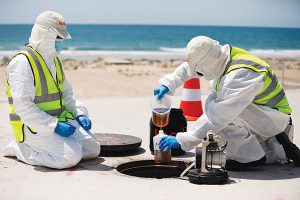Israeli scientists monitoring samplings of sewage water in 2013 made a startling discovery: an outbreak of paralysing polio was imminent. A national vaccination campaign was quickly mobilised and no cases appeared. That same year, Swedish scientists provided public officials with an early warning for outbreaks of hepatitis A and norovirus using the same methods.
If we are to regain, and retain, normal living, we’ll need the same kind of early warning system for future variants and pandemics. Fortunately, we’re getting closer to having that.
Monitoring sewage systems is now one of the hottest areas of pandemic research, as viral RNA is shed through feces. Used properly, this approach could help public health authorities build resilience against virus outbreaks.
Already wastewater surveillance has provided authorities with a picture of rising Omicron rates. Britain has wide-scale wastewater surveillance (sampling covers 70% of the population of England) — no small feat given the age of the sewage system. Monitoring was ramped up during the pandemic under the UK Health Security Agency. Omicron found in wastewater has aligned with clinical trends observed across the country since the beginning of
December.
Slushing through sewage for insights into public health is hardly new. London doctor John Snow traced cholera outbreaks in the mid-19th century to contaminated water. For decades, scientists have looked for viral pathogens and other biomarkers, including illicit drugs, in the water we flush from hospitals, homes and businesses. And yet, prior to the Sars-CoV-2 pandemic, most sewage monitoring was relatively small-scale, often focused on retrospective samples analysed largely for academic or broad
public health purposes.
The Netherlands was one of the first countries to demonstrate that Sars-CoV-2 could be picked up in sewer systems. Ever since, research funding has poured into the area. Surveillance systems were cobbled together, scaled up and made to work faster. Some countries have sophisticated
public-facing dashboards.
Federal agencies in the US set up the National Wastewater Surveillance System to inform and coordinate the patchwork of state and local efforts. Scientists at the University of California Merced have helpfully created a sweeping CovidPoops19 dashboard to post information on global wastewater testing, currently covering
efforts in 58 countries.
Such systems may be our best leading indicator, at least if those doing the sampling know what they are looking for. Scientists at the University of Barcelona tested archival wastewater samples (which had been frozen) and found the presence of Sars-CoV-2 dating back to mid-January 2020, 41 days before the announcement of the first case on February 25.
Sewage sampling in Paris in 2020 revealed viral RNA that anticipated the shape of infection curve. In certain contained settings, such as schools, care homes or airports, wastewater sampling can provide critical time for health authorities to mobilise clinical testing or other policies. In one study in Britain, Covid was detected in the sewage system of 80% of schools studied a week before community tests provided confirmation.
The technology for wastewater surveillance is in some ways very basic, but there are complexities that can get in the way of getting accurate readings or using them for policy. Unlike the viral RNA found on a nose or throat swab, wastewater contains a great many biological and chemical substances that can muddy the picture. Changes in the physical and chemical composition of sewage mean it’s inherently less stable than your standard nasal swab.
The simplest technique is what’s known as a grab sample — pretty much a ladle dipped in sewage water. But samples can be affected by any number of factors from the time of day (most people use the bathroom in the mornings) to the weather (heavy rainfall can impact things). More sophisticated surveillance, known as composite sampling, uses programmable pumps to draw water at regular intervals.
The effects of dilution, hydraulic action in sewage systems, water chemistry and other factors mean the viral signal can vary significantly between test sites, making comparison difficult. Samples also need to be refrigerated during transport. And interpreting data requires both epidemiological expertise and experts on statistical methodology and wastewater specialists.
Then the onus is on authorities to put the information to good use. That seems to be happening at the community level in some places. A team of researchers at the University of Kentucky has developed a new technology for extracting the viral RNA from wastewater using magnetic beads and partnered with the owners of nursing homes and long-term care facilities to use wastewater surveillance to get an early warning of infections there.
Indeed, UK health authorities view surveillance as supplementary information; it’s not clear how exactly it’s used for decision making or what the thresholds are for triggering a policy response. Belgium uses three “alerting indicators†based on viral concentration levels and the speed and trend of increase in wastewater and publishes its findings, which at least adds transparency.
If we are to build more resilient response systems to future variants and pandemics, then governments need to direct more resources to wastewater surveillance methods, infrastructure and training (including in rural areas and developing countries where testing isn’t widely available). Increased sewage monitoring could even play an essential role in what may be the next major health crisis we face — antimicrobial resistance.
As we hopefully emerge from Omicron, it’s nice to know that some smart people have their heads in the gutter.
—Bloomberg
Therese Raphael is a columnist for Bloomberg Opinion. She was editorial page editor of the Wall Street Journal Europe
 The Gulf Time Newspaper One of the finest business newspapers in the UAE brought to you by our professional writers and editors.
The Gulf Time Newspaper One of the finest business newspapers in the UAE brought to you by our professional writers and editors.

